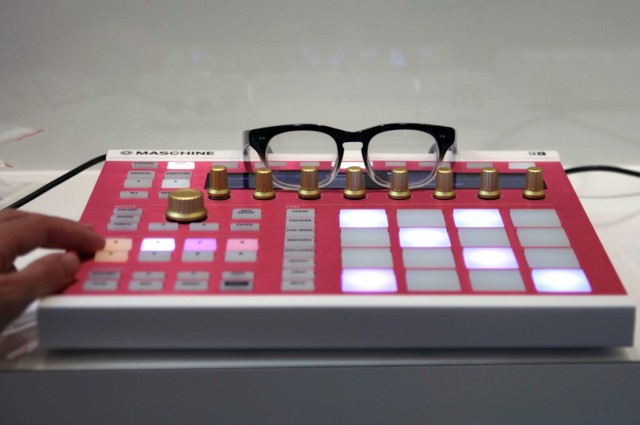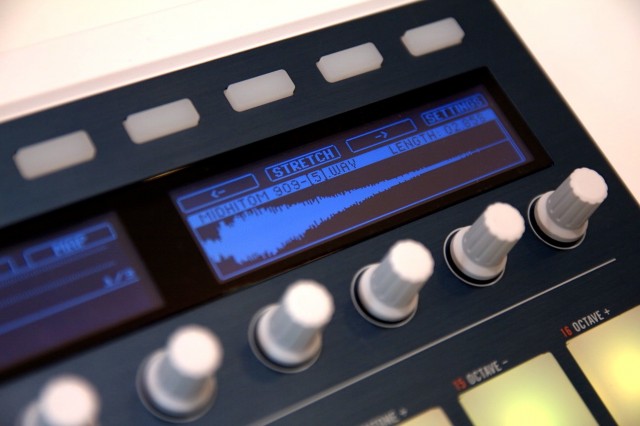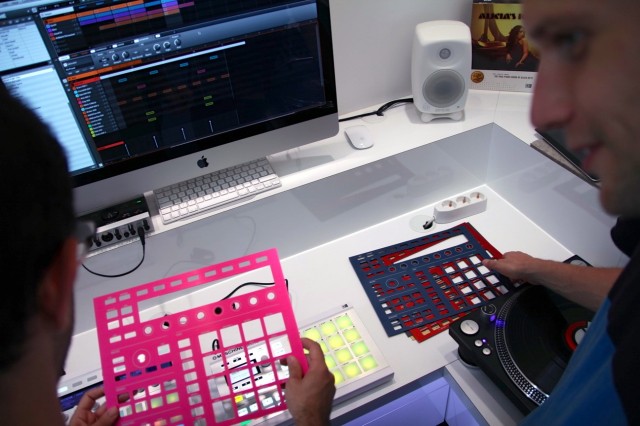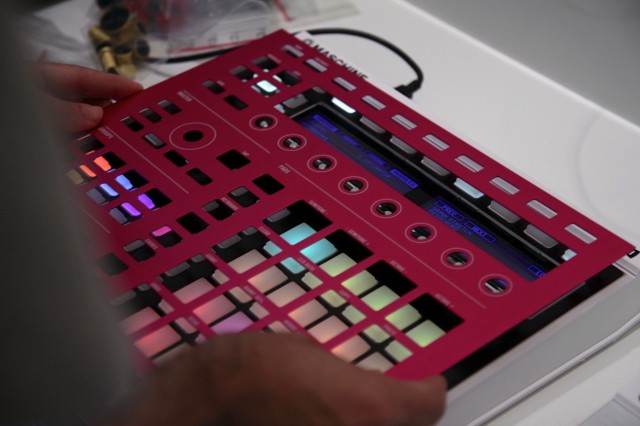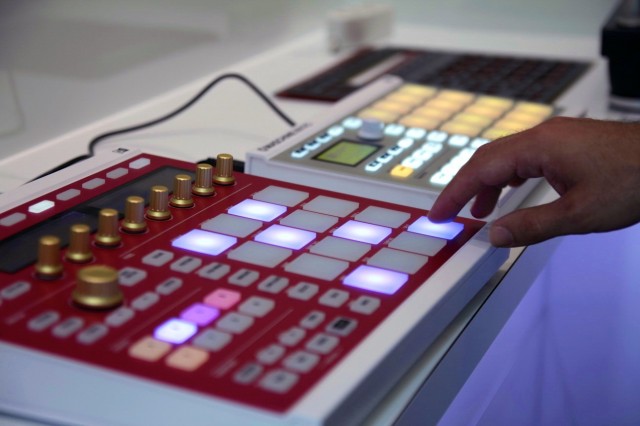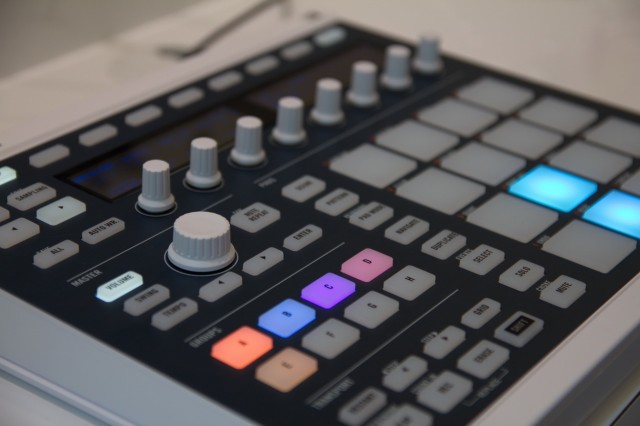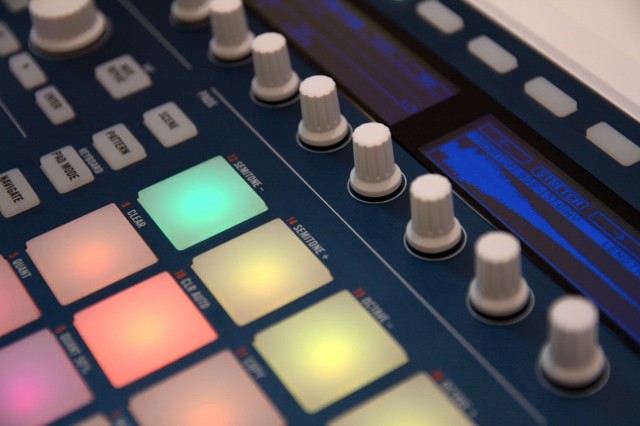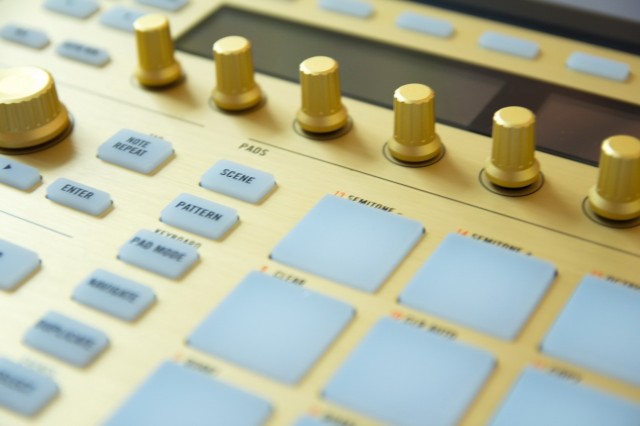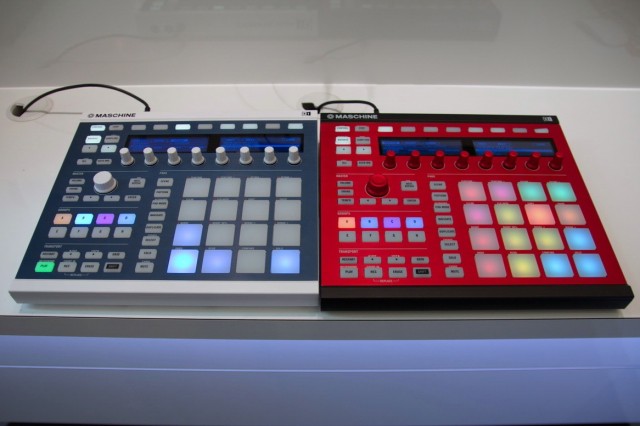In living color: the popular drum machine – combining integrated hardware and software – is more colorful, but also more usable, via updates to the screen and pads alike. We’ve gotten a hands-on test with the gear to share some first-hand first impressions.
Native Instruments’ Maschine hardware gets a major update today, and color is likely the first thing you’ll notice. The pads are backlit with a rainbow of RGB LEDs, as found on NI’s Kontrol F1 for Traktor. Unlike the F1 and other colored pad controllers, though, here you get both color pads and velocity sensitivity. Color choices extend to the Maschine hardware itself. The body is available in white or black, and interchangeable overlays and knob caps let you mod the look of your box.
Both the bigger Maschine and the mikro get the full color treatment on the pads, and the new software and workflow features. (Only the big-daddy Maschine – makro? – gets interchangeable faceplates. But you can still choose between white and black on the little one.)
And, yes, color on the pads responds to MIDI. That means unique custom templates for tools like Ableton Live or Renoise could be in store.
NI has a rather nice video showing off Jeremy Ellis playing a set in one take. (The music is one take, anyway; the video is more than one take.) That’s not a fan driving the wind – that’ll be the natural Berlin weather high atop the abandoned, US-built Teufelsberg listening station.)
Hardware
The update isn’t just skin-deep, though. There are a number of improvements to the hardware:
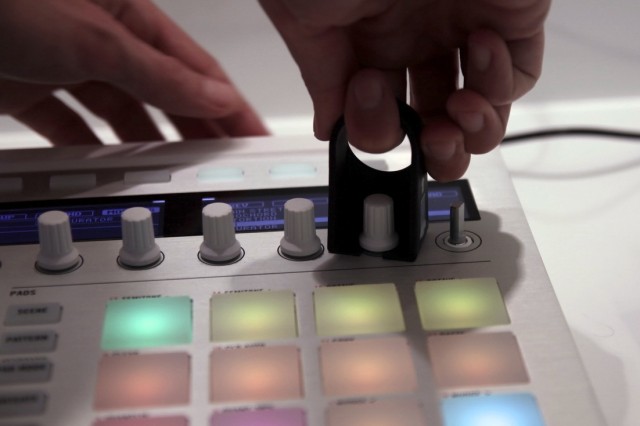
A clever tool, which we think should be called the Dekapitator, safely removes knob caps so you can swap the overlays. Then, both the knob caps and the overlay around the pads and buttons can be a custom color. (See the gallery for more.)
Pad response: I’ve talked to many artists who already felt that the drum pads on the Maschine were the best-feeling ones available. Jeremy Ellis, of course, is an NI-sponsored artist, but I take his opinion seriously; the guy is pushing the envelope of finger drumming more than any of the rest of us. Other artists, too, liked the feel. On the new Maschine, that familiar pad design is back, but now slightly tweaked for even firmer feedback and incredibly-precise velocity response. As a pianist, I really appreciate that difference. With velocity scaling set to linear and sensitivity turned all the way up, even lightly brushing a pad with your finger could trigger accurately – without any nasty double-triggering. You then get the sense of a full velocity response line as you hit harder, to the point when you’re really slamming the pads and everything in between. Velocity scaling is adjustable in Maschine’s preferences, too, so you can adjust to the way you play.
Buttons that ‘click’: The one thing people may not have liked as much as the pads is the other, digital buttons on the unit. These felt a bit spongy for selecting editing options, since you’re using them as toggle switches rather than as pads. Now, there’s a satisfying “click” as you tap the other controls. (To be clear: the buttons that control editing options, transport, and the like, ‘click’ – you don’t get that on the drum pads, as that wouldn’t make any sense!) Clarification: Note that the click buttons are only on the full-sized Maschine, not the mikro. Apart from the different layout and display, this is really the only difference between the mikro and Maschine; I understand this is an engineering requirement of the mikro’s PCB and those RGB LEDs, not a marketing differentiation.
Single selection encoder: The master push-encoder replaces the three side-by-side encoders on the first Maschine hardware. It’s a lot better-suited to browsing through sample files and the like; I got to try it a little bit with the new software.
Better viewing angles on the display: It’s subtle, but new displays are easier to see at an angle. Not that you’ll be using uncomfortable viewing angles very much, because there’s also:
A new, rugged road stand. On your desk or in the studio, this tilts up the Maschine controller for easier viewing and use. Even better, you can attach it to a standard snare stand and get a performance-ready Maschine controller adjustable to the most comfortable position. (You can even tilt the Maschine toward your audience, so they can enjoy the colored light show and your finger-drumming chops – and you keep your wrists in better alignment.)
The stand works with the old hardware, as well.
1.8 Software
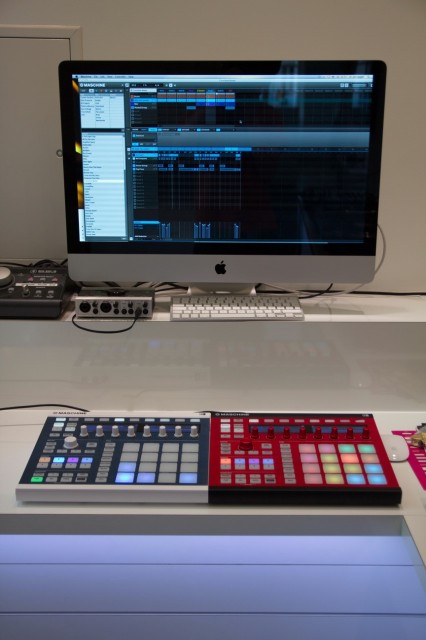
Integrated hardware and software is part of what sets Maschine apart; whichever generation of hardware you have, you’ll now get enhanced functionality, more effects, and a free copy of Massive.
There are also new software features, and with the exception of color schemes, they all work with the original Maschine and Maschine mikro hardware:
You get Massive, you get Massive, you get Massive, everybody gets Massive! Yes, Massive is now bundled free for all users with the 1.8 software update. That means everyone can begin producing dubstep take advantage of this deep, semi-modular sound design wonder, for any number of musical genres or ideas. And it puts synthesis and not just sampling front and center with Maschine. (You can also host your own plug-ins, but the integration with Maschine is nothing if not convenient – and should unlock synthesis possibilities for future NI sound packs, of course, if you want someone else to do a bit of that sound design for you.)
Offline time stretching and pitch shift. There are many new options here for manipulating samples, in a much-requested improvement on the software side.
Color schemes: If you do get the new hardware, you can use standard color schemes to more easily differentiate between sounds, groups, patterns, and projects. There are presets for you, too, just in case you’re afraid you’re going to wind up spending all your time honing your synesthesia and picking color schemes rather than making actual music. (I … can’t possibly … imagine that … happening … what color is a snare, anyway?)
New effects: Transient Master (a transient follower) joins Tape and Tube Saturators for added processing possibilities.
Auto-Write Pinning: Okay, the term here probably means nothing to you, so here’s the idea: you know how it’s annoying to hold down one button as you, say, twist an encoder for editing? Now, by holding down “shift,” you can lock the edit mode for one-handed operation. You can adjust the pitch of your kick as you use the other hand to sip a Club-Mate/Big Gulp (depending on the part of the world you’re in).
Host Transport Control: If you’re using Maschine inside software like Ableton Live, you can at last use Maschine’s transport controls to run the transport for the host – like playing your session.
Browser Sample Preview Mode: That speaks for itself, but it’s particularly fun on the new encoder.
Locate misplaced samples: Previously, if you moved a folder, you would have to relocate files one-by-one; now you just point at the whole folder and Maschine updates sample paths all at once.
These software updates don’t necessarily address everything Maschine users have been requesting – yes, sidechaining would still be nice, as would (insert the thing you want here). But Maschine is continuing to mature nicely.
Price + Dates
Availability: Everything here will be available by October 1.
Pricing:
MASCHINE $669/ 599 EUR / 62.800 ¥
MASCHINE MIKRO $399 / 349 EUR / 36.800 ¥
MASCHINE CUSTOM KITS $79 / 69 EUR / 7.800 ¥
MASCHINE STAND $79 / 69 EUR / 7.800 ¥
(By the way, if that stand seems pricey, I will say, it feels really, really rugged. The Custom Kits are more of a splurge, only because the default white and black do look nice enough, but the overlays and knob caps also feel nicely-made. It depends on how much you value a little bling)
These are just first impressions; watch for a full review when this ships. I think it’s going to be a busy fall. If only I lived in a place that quickly turned cold, dark, and depressing, where I wanted to lock myself up and just make music for hours of time, with easy access to the people making all the music tools…
Gallery
Arvid Jense, interning with CDM here in Berlin and himself studying industrial design and how it applies to musical instruments, sat in on our hands-on session and snapped all these photos for CDM. The next new gear we see might come from him.
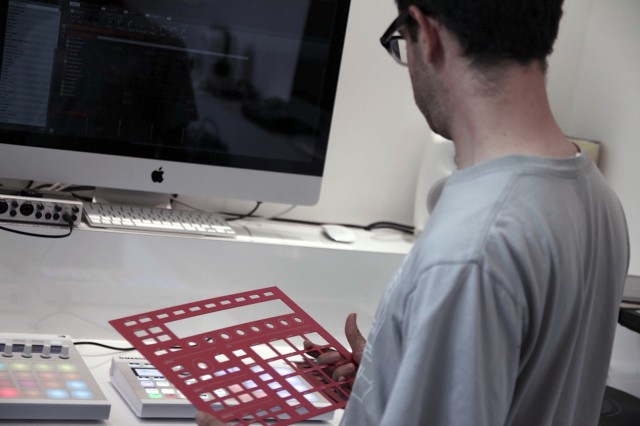
These aren’t thin, plastic overlays: the new overlays feel quite rugged and come with custom knob cap colors. And yeah, men can rock the pink, too, just as lady Maschine owners can opt for the lovely graphite color.
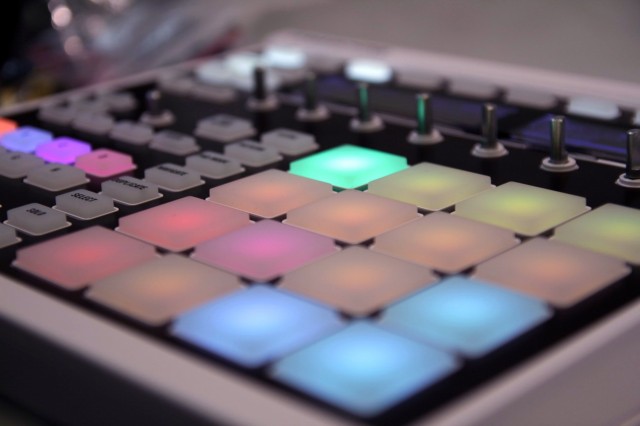
Parents, hide your kids’ eyes – this is a Maschine naked, minus its overlays. (actually, looks kinda nice)
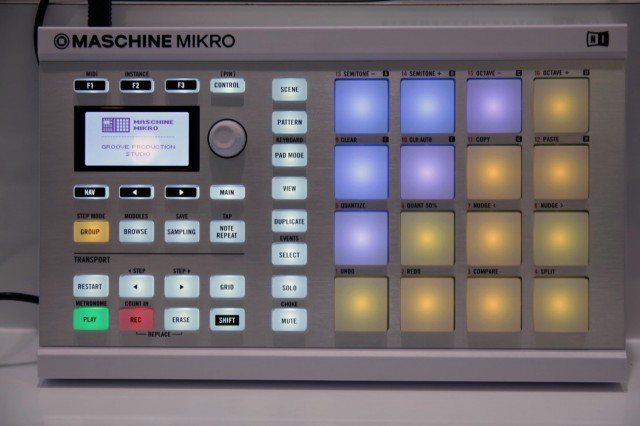
The mikro may lack interchangeable overlays and the stand, but it’s a terrific bargain. You still get an integrated display, color pads, and the new master encoder. Correction: It does not have the click-feel buttons, but it’s otherwise functionally the same. Liking the new white, as well.
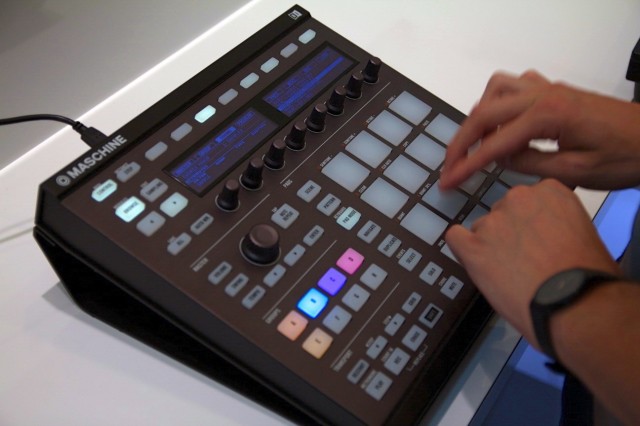
This color might be our favorite. Here, you can see how the stand – minus its attachment – can tilt up the controller on your desk. And pad velocity responsiveness feels great.
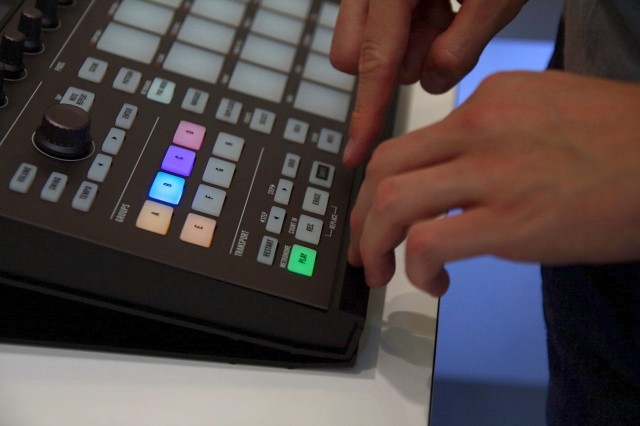
Transport controls now trigger software like Ableton Live, too, when you’re running inside a host. The buttons on this side also add a satisfying click feel.
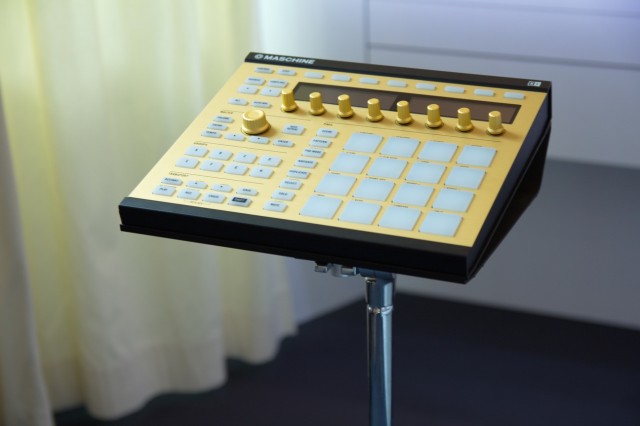
Have you seen her all in gold / Like a queen in days of old? As mounted on a snare stand. (you’ll have to provide the stand; NI gives you a standard attachment)
www.native-instruments.com/
http://www.native-instruments.com/#/en/products/producer/maschine/
http://www.native-instruments.com/#/en/products/producer/maschine-accessories/maschine-custom-kits/
